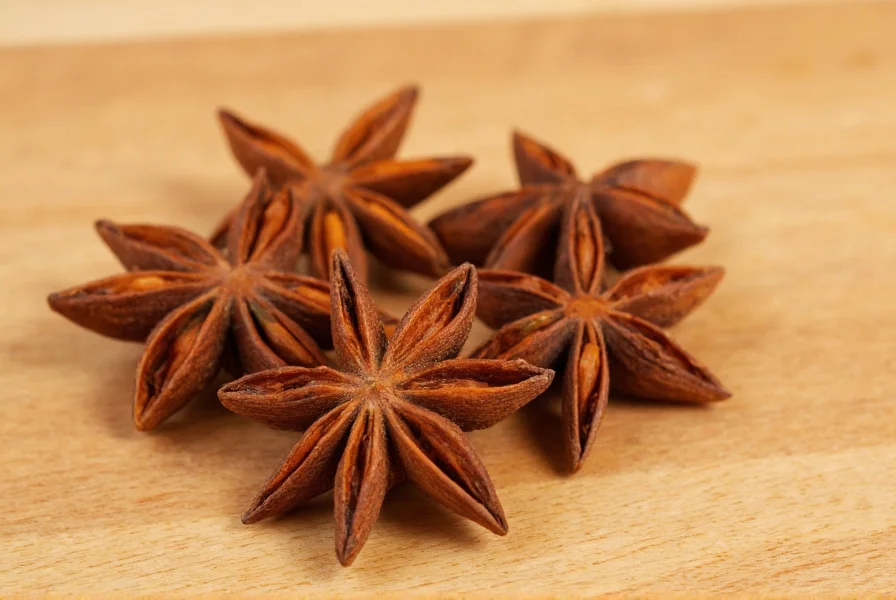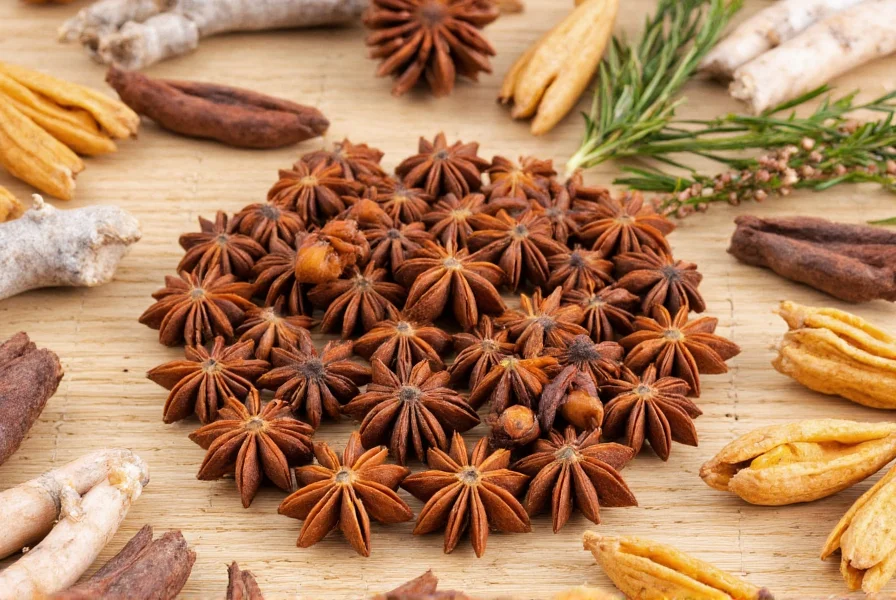Star anise has been valued across cultures for centuries, not just for its unique flavor profile but for its versatile applications that extend far beyond the kitchen. This distinctive spice, harvested from the fruit of the evergreen Illicium verum tree native to Southwest China and Vietnam, offers a complex sweet-licorice taste that enhances both savory dishes and sweet preparations. Understanding what star anise is used for reveals its importance in global culinary traditions and wellness practices.
What Exactly Is Star Anise?
Star anise consists of star-shaped seed pods that range from 2.5-5 cm in diameter, typically containing 6-8 pointed segments. Each segment houses a single seed responsible for the spice's potent flavor. Unlike anise seed (which comes from a completely different plant in the parsley family), star anise belongs to the magnolia family and offers a more intense, complex flavor profile with warm, sweet notes reminiscent of licorice, cloves, and fennel.

Culinary Applications of Star Anise
When exploring what is star anise used for in cooking, its role as a fundamental component in many spice blends and dishes becomes immediately apparent. Professional chefs and home cooks alike rely on this spice for its ability to add depth and complexity to various preparations.
Asian Cuisine Foundation
Star anise serves as one of the essential ingredients in Chinese five-spice powder and Vietnamese pho broth. In Chinese cooking, it's indispensable for braised dishes like red-cooked pork and beef, where it imparts warmth without overwhelming heat. The spice's compounds are fat-soluble, making it particularly effective in slow-cooked meat dishes where it can fully infuse the preparation.
Baking and Desserts
Beyond savory applications, star anise enhances baked goods and desserts with its aromatic profile. Bakers incorporate it into:
- Spice cakes and gingerbread
- Fruit compotes and poached pears
- Custards and ice cream bases
- Cookie and pastry fillings
Beverage Flavoring
One of the most common questions about what star anise is used for involves beverage preparation. The spice enhances:
- Chai tea blends (often combined with cardamom, cloves, and cinnamon)
- Homemade syrups for cocktails
- mulled wine and cider during colder months
- Traditional Chinese and Vietnamese coffee preparations
| Culinary Application | Recommended Quantity | Best Paired With |
|---|---|---|
| Meat braises (4 servings) | 1-2 whole stars | Cinnamon, ginger, soy sauce |
| Stocks and broths (1L) | 1 whole star | Black cardamom, coriander |
| Baking (per 500g flour) | ½ tsp ground | Nutmeg, allspice, citrus zest |
| Tea infusion (single serving) | 1 star | Orange peel, cloves, black tea |
Traditional Medicinal Uses of Star Anise
Long before modern science examined its properties, traditional Chinese medicine and Ayurvedic practices incorporated star anise for various wellness applications. Understanding what star anise is used for medicinally reveals centuries of empirical knowledge that modern research continues to investigate.
Digestive Support
Traditional healers have long used star anise to address digestive discomfort. The spice contains anethole, a compound that may help relax gastrointestinal muscles and reduce bloating. Many cultures prepare star anise tea after meals to support digestion and alleviate gas.
Respiratory Relief
When examining what is star anise used for in respiratory health, its traditional use as an expectorant stands out. The spice appears in many traditional cough syrups and chest rubs, particularly in Asian medicinal practices. Its warming properties may help loosen mucus and ease breathing during cold season.
Antimicrobial Properties
Research suggests that star anise contains compounds with potential antimicrobial effects. Traditional applications include using star anise infusions as a natural mouthwash to support oral health, though these uses shouldn't replace professional dental care.

How to Use Star Anise Effectively
Knowing what star anise is used for only becomes valuable when you understand how to incorporate it properly into your cooking and wellness routines. The spice's potency requires thoughtful application to achieve the best results without overwhelming other flavors.
Whole vs. Ground Star Anise
Whole star anise provides the most intense flavor and is ideal for long-cooking dishes where the spice can gradually release its compounds. Ground star anise works better for baking and quick preparations but loses potency faster. For maximum freshness, grind whole stars as needed using a dedicated spice grinder.
Measurement Guidelines
Star anise's strong flavor means a little goes a long way. As a general rule:
- For soups and stews: 1 whole star per liter of liquid
- For braises: 1-2 stars per pound of meat
- For baking: ¼-½ teaspoon ground per 500g of flour
- For tea: 1 star per 8oz of water
Pairing With Complementary Spices
Star anise combines beautifully with other warm spices. Common pairings include:
- Cinnamon and cloves for holiday baking
- Sichuan pepper and fennel for Chinese five-spice variations
- Cardamom and ginger for chai blends
- Orange zest for fruit-based preparations
Safety Considerations and Potential Side Effects
While exploring what star anise is used for, it's crucial to understand safety parameters. Japanese star anise (Illicium anisatum) is toxic and should never be consumed, though it's rarely found in Western markets. True Chinese star anise (Illicium verum) is generally recognized as safe when used in culinary amounts.
Pregnant women should consult healthcare providers before consuming star anise medicinally, as high doses may affect hormone levels. Individuals with estrogen-sensitive conditions should exercise caution due to potential phytoestrogen content. As with any spice used for wellness purposes, moderation remains key.
Star Anise Substitutes
When you're wondering what to use instead of star anise, several alternatives can approximate its flavor profile:
- Anise seed (use ½ teaspoon for each star anise)
- Fennel seeds (milder, with similar licorice notes)
- Chinese five-spice powder (contains star anise plus other spices)
- Fenugreek (use sparingly, different flavor but similar warming quality)
Conclusion: The Versatile Applications of Star Anise
Understanding what star anise is used for reveals its remarkable versatility across culinary, beverage, and traditional wellness applications. This distinctive spice enhances dishes with its complex flavor while offering potential health benefits that have been recognized for centuries. Whether you're crafting an authentic pho broth, baking spiced cookies, or preparing a soothing after-dinner tea, star anise delivers unique aromatic qualities that elevate your preparations. By incorporating this spice thoughtfully and understanding its proper applications, you can expand your culinary repertoire while connecting with global traditions that have valued star anise for generations.
Frequently Asked Questions
What is star anise commonly used for in cooking?
Star anise is commonly used in Asian cuisine, particularly in Chinese braised dishes, Vietnamese pho broth, and Indian curries. It's also essential in spice blends like Chinese five-spice powder and adds distinctive flavor to baked goods, chai tea, and mulled beverages.
Can star anise help with digestion?
Yes, star anise has been traditionally used to support digestion. The compound anethole may help relax gastrointestinal muscles and reduce bloating. Many cultures prepare star anise tea after meals to aid digestion, though scientific evidence for these effects remains limited.
How do you use star anise in tea?
To use star anise in tea, add one whole star to 8 ounces of hot water and steep for 5-7 minutes. It pairs well with black tea, orange peel, and cloves. For stronger flavor, gently crush the star before steeping. Remove the whole star before drinking as the seeds can be quite hard.
Is star anise the same as anise seed?
No, star anise and anise seed come from completely different plants. Star anise (Illicium verum) is a star-shaped fruit from an evergreen tree in the magnolia family, while anise seed (Pimpinella anisum) comes from a flowering plant in the parsley family. Though both contain anethole and have similar licorice-like flavors, star anise has a more complex, woody note compared to the sweeter anise seed.
Can you eat star anise whole?
While star anise is safe to steep in dishes and beverages, the whole pods are typically removed before serving as they remain quite hard even after cooking. The seeds inside can be chewed but are quite strong and may be uncomfortable to eat whole. For safety and optimal flavor, recipes usually call for removing whole star anise after it has infused the dish.











 浙公网安备
33010002000092号
浙公网安备
33010002000092号 浙B2-20120091-4
浙B2-20120091-4